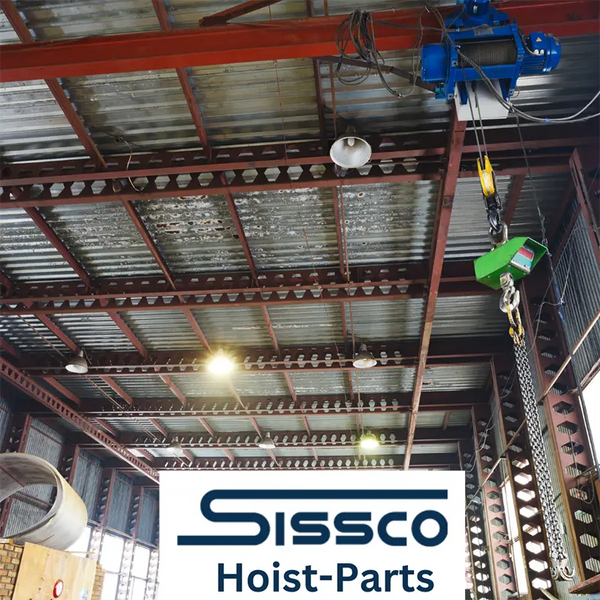
The most dangerous hoist is the one that almost works perfectly. It's moving loads, hitting limits, mainly sounding right. But it's quietly breaking itself in the process. If you've ever watched a Manguard electric chain hoist stall halfway up with a half-ton load, you know the chain didn't stretch overnight. If you've ever pulled a Series 6000 air hoist apart to find gear teeth missing, you see the brake had been slipping for weeks before it finally let go.
Budgit Hoist part manuals don't hide the truth: the majority of in-service failures start in the same handful of parts. They're measurable, predictable, and preventable, if you know exactly what to look for and act before "almost fine" turns into "out of service."
1. Load Chain – The Wear You Can't See Until You Measure
Some failures on Budgit Hoist parts are visible from across the shop. Load chain wear isn't one of them. The chain on a BEHC electric might look solid, oiled, and free of cracks, but Budgit's own specs say that if a 12-link section is more than 1.4% longer than new, it's beyond its safe working limit. On a 5/16" chain, that's less than the thickness of a nickel.
Quick field check:
· Wipe chain clean (Manguard manuals say dirt + oil = grinding paste).
· Lay it alongside a new chain or reference section.
· If it's visibly longer, even slightly, measure with calipers.
In a Series 6000 air hoist, stretched links won't seat deep into the pocket wheel. That causes the chain to "jump" under tension, shock-loading the gearbox and brake. Ignore it long enough, and you'll be replacing more than the chain.
2. Hooks – A Small Change in Shape is a Big Red Flag
Two ways Budgit hooks tell you they're done:
1. Throat Opening Growth
a. Example: A 1-ton Manguard lower hook starts at a 1.25" opening. Budgit's limit is +15% (about 1.44").
b. Beyond that, the hook can roll the load right out under slack and vibration.
2. Twist from Original Alignment
a. Measured from the plane of the hook shank.
b. Limit: 10° twist. Seen often in BEHC hooks after years of angled lifts.
A twisted or stretched hook is never just a hook problem. Budgit warns that deformation usually means the chain, load wheel, or even the trolley has taken overload forces. Treat the hook as the canary in the coal mine; if it's deformed, you have more inspection ahead.
3. Braking Systems – Three Different Budgit Hoist Part Setups, Three Different Failure Patterns
The "brake" isn't one thing across Budgit's lineup.
|
Model |
Brake Type |
Common Failure Mode |
Inspection Trigger |
|
Manguard Electric |
Electromagnetic motor brake |
Glazing from heat during high-duty cycles |
Longer stopping distance under rated load |
|
Series 6000 Air Hoist |
Mechanical load brake |
Oil contamination from motor lubrication |
Intermittent slip after lifts |
|
Budgit Hand Chain Hoist |
Weston-type load brake |
Worn friction discs |
Creeping load in drift test |
Budgit Hoist part manuals recommend the drift test daily: lift a load a few inches, stop, and watch. Any movement means the brake isn't holding and must be adjusted or rebuilt. A slipping brake doesn't just risk dropping the load; it hammers the gearbox and overload clutch every time it lets go.
4. Overload Clutch – When Protection Becomes a Problem
The overload clutch is factory-set; on many Manguards, that's 125–150% of rated load. Done right, it's your last mechanical safeguard. Done wrong, it's a capacity killer or a silent destroyer.
Two failure personalities:
1. Overly Sensitive: Starts slipping on jobs well below capacity. You lose productivity, operators start "bumping" the controls to force the lift, and the clutch overheats.
2. Seized: No slip at all. That's a straight path to bent hooks, stretched chain, and stripped gear teeth if someone overloads the hoist.
Budgit's directive: no field tinkering. A clutch with changed behavior goes to the bench for a rebuild or gets replaced. Anything else is rolling the dice with every lift.
5. Limit Switches and Stops – The Quiet Safety Net You Can't Afford to Tear
Let's be blunt: a failed limit switch can destroy a hoist in under two seconds. On BEHC electrics with mechanical paddle limits, the small chain-mounted actuator is everything; lose it, and the upper block will smash into the hoist body at full motor speed.
On newer electronic-limit Manguards, you can dial in travel limits to the inch. But Budgit warns operators not to "drive into the limits" as a normal stop. The sudden decel under load is severe enough to damage the stop mechanism and deform load-bearing parts.
Preventive habits worth stealing:
· Test both upper and lower limits slowly every shift.
· On mechanical limits, confirm actuator position against Budgit's chart.
· Replace missing or damaged actuators immediately — they're cheap, hoists aren't.
The Specs Aren't Suggestions
Budgit's tolerances for chain pitch, hook throat, brake hold, clutch slip, and limit function aren't there to make inspection logs longer. They're there because in the real world, a part that's just past spec is already in the failure zone.
Whether it's a Series 6000 in a foundry, a BEHC over a busy assembly line, or a Manguard in a production bay, these five checkpoints are the thin line between reliable lifts and preventable downtime. Run your inspections by Budgit's numbers, not by "feels fine," and you'll catch the small problems before they teach you expensive lessons.